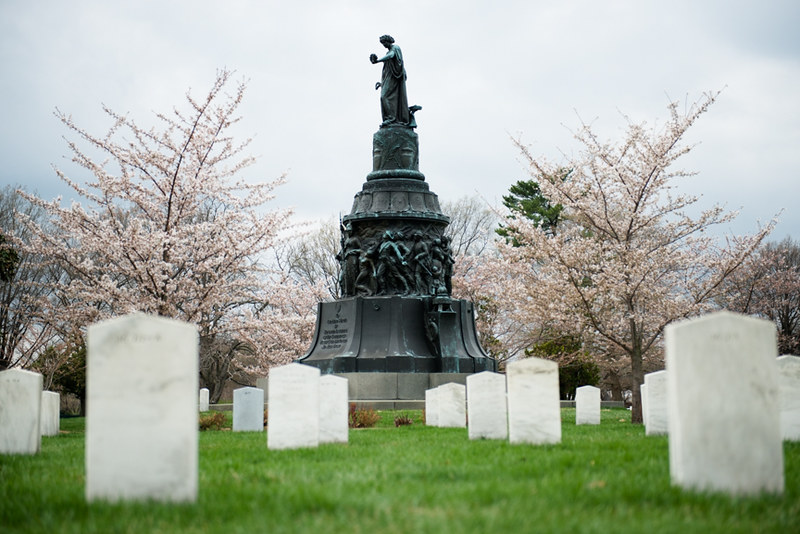At the 11th hour on Monday, a federal judge in Alexandria, Va. issued a temporary restraining order to halt workers’ efforts — which had begun several hours prior — in removing the controversial Confederate memorial in Arlington National Cemetery.
The memorial remains one of the nation’s most prominent monuments to the Confederacy on public land and has been criticized “for its sanitized depiction of slavery,” writes The New York Times.
The removal, which was set to be completed by the end of the week, comes at the tail end of efforts across the United States for the past several years to remove symbols, flags and monuments honoring slaveholders and Confederate leaders.
According to NPR, a group called Defend Arlington, which is affiliated with a group called Save Southern Heritage Florida, brought their suit before U.S. District Judge Rossie Alston Jr. on Sunday.
The group is suing the Department of Defense, arguing that the “The removal will desecrate, damage, and likely destroy the Memorial longstanding at ANC as a grave marker and impede the Memorial’s eligibility for listing on the National Register of Historic Places.”
They were granted the injunction by accusing the Pentagon of rushing its decision and circumventing federal law by not issuing an environmental impact statement. A hearing on the matter is scheduled for 10 a.m. on Wednesday.
Fourteen years after Congress authorized Confederate remains to be reinterred at Arlington in 1900, the statue was dedicated by President Woodrow Wilson and funded by the United Daughters of the Confederacy — an organization that helped to largely forge the Lost Cause ideology.
According to Karen L. Cox, a professor of history at the University of North Carolina at Charlotte, the statues around the United States didn’t appear in great numbers for more than 30 years after the war. Founded in 1894, “an early objective of the UDC was the erection of monuments as tangible signs of pride and appreciation,” Cox writes.
As such, during the early 20th century, more than 700 monuments were erected across the South before World War II.
The 1914 Arlington unveiling, however, served as a watershed moment for the UDC. By allowing the burial of Confederate soldiers in Arlington and “accepting the monument to honor them, the federal government had fulfilled the Daughters’ conditions for reconciliation,” Cox posits.
The bronze and granite memorial stands in what is now known as section 16, towering over the remains of the Confederate soldiers buried there.
Last week more than 40 Republican members of Congress signed a letter demanding that Defense Secretary Lloyd J. Austin III halt the removal, the NYT reported. They argued that the memorial did not commemorate the Lost Cause ideology but rather the “reconciliation and national unity” between North and South.
Others, however, find the 32-foot pedestal more controversial. The 32-foot pedestal, designed by Confederate soldier Moses Ezekiel, features a bronzed statue of a beautiful woman that represents the South, standing over a frieze of figures that include two African Americans: “an enslaved woman depicted as a “Mammy,” holding the infant child of a white officer, and an enslaved man following his owner to war,” the cemetery website reads.
Virginia governor, Glenn Youngkin, has been steadfast in his opposition to the removal but had secured a plan for the Virginia Military Institute — where Ezekiel was once a cadet — to take ownership of the statue and place it at the Virginia Museum of the Civil War at New Market Battlefield State Historical Park, writes The Washington Post.
The debate over “heritage, not hate” continues to play out on the national stage, yet, as David W. Blight, professor of American history at Yale University, tells HistoryNet, “History and memory are not the same thing. History is based on reasoned research. Memory is born of groups and forged in myriad ways; passed down generation to generation, it tends to be more emotional and sacred.
“Heritage” can make us want to own a past, a story, a place against all other possible narratives or interpretations. A person using a symbol in public or in official ways must understand how the public views their actions. There is always going to be more memory than there is history, but those of us who are devoted to the craft of history have a deep responsibility to push back against memory even as we genuinely respect its power.”
historynet magazines
Our 9 best-selling history titles feature in-depth storytelling and iconic imagery to engage and inform on the people, the wars, and the events that shaped America and the world.






